At Westwater Ranger Station, we are joined by Mike Wight of the Southwest Conservation Corps. Mike’s here to float with us past the Dolores River confluence...
Agriculture and the Colorado River
If you've ever eaten a salad in winter, there's a good chance it was grown with Colorado River water.
Fracking Along the Colorado River
Fracking, like any truly controversial topic, has developed the tendency to repel stable facts with magnetic force.
Do Healthy Rivers Make a Stronger Economy? River Recreation, Part II
This blog was originally published in the Huffington Post. Click here to read on Huffpo. A swarm of yellow life jackets pours out of rafts on the Colorado River and flows upward, single file, to the top of a small cliff. One by one they jump, letting out a quarter-second, midair yelp before disappearing into the water below. It's summer on the Pumphouse section of the Colorado, just upstream of the tiny raft guide enclave of State Bridge. Although this particular cliff is more than an hour's drive from any significant population center and nearly three hours from Denver, the commercial rafts float by our camp in an almost unbroken procession throughout the morning. As our expedition floated downstream towards Glenwood Springs, we saw this scene repeated again and again in various forms -- tubers, rafters, fishermen, and picnickers flocking to the river to find some relief from the heat and to enjoy a day beside moving water.
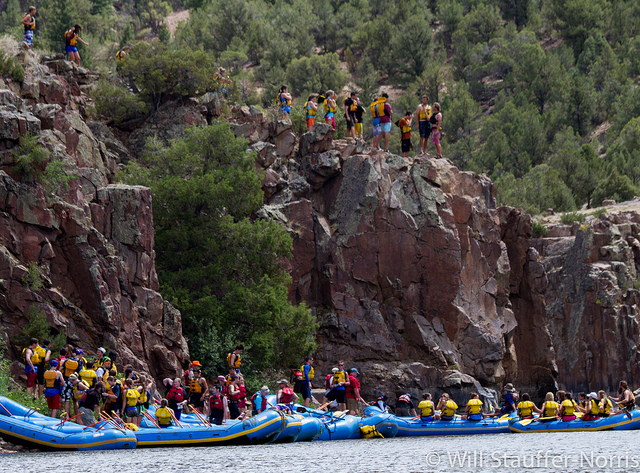
In an election year like this one some candidates would like us to believe that to be pro-economy you have to be pro-growth, pro-drilling and in favor of new water projects such as reservoirs and diversions. According to this mentality, anything that's going to protect our state's natural resources is going to kill jobs and hurt our wallets. But there are other voices speaking up to say the direct opposite: that a strong, stable economy in Western Colorado is going to be built not on the booming and busting cycles of resource extraction, but on the seasonal, sustainable cycles of resource preservation. People who come to enjoy the Western Slope of Colorado to raft, fish, hunt, bike, camp, or simply to sightsee are drawn by the recreational opportunities the mountains and rivers have to offer as intact mountains and rivers.
As our expedition team floated down the length of the Colorado, we met with many river experts who commented on value of river recreation. First was Molly Mugglestone, the project coordinator for river-advocacy group Protect the Flows, who met with us to explain the river's contribution to the regional economy. Mugglestone has spent the last year creating a coalition of over 500 businesses in the Colorado River Basin who rely on a healthy river for their livelihoods. Coalition members range from the obvious rafting and fishing companies to small businesses in tourist towns who need the yearly influx of people to stay in business. Together Protect the Flows and the businesses they represent have been speaking up for the needs of a recreation economy.
"Policy makers have been really receptive to our message," Mugglestone said, "because we represent economic vitality. We represent jobs. We represent small businesses trying to survive with the economy and also with the drought." Helping to quantify the value of a healthy river system is a recently released Protect the Flows study which estimates the Colorado River generates an economic output of $26 billion annually and employs a quarter of a million Americans. In the state of Colorado alone $9.6 billion is produced from river-related business.
Summer in Glenwood Springs, Colorado is living proof of the report's findings. Not only do independent businesses survive on river recreation, but the local government has invested over a million dollars in a public whitewater park in town. When our expedition floated through, we broke out our own kayaks and spent the day on the artificial wave. The park, which was constructed in 2008, consists of several river features that kayakers of all ages play in, surfing the waves and practicing tricks in the holes. During high water, even surf boarders come to ride the artificial hydraulics. Crowds of spectators form on hot summer days, sometimes outnumbering the number of boaters in the water. Glenwood's park is just one of over 20 new Colorado whitewater parks built in the last decade.
Whitewater parks hold a unique place in the Colorado legal system. According to state law, water rights can only be obtained if the water is put to "beneficial use." Traditionally beneficial has meant agriculture, municipal and industrial uses, or hydropower. But, as the Protect the Flows report demonstrates, recreation makes a considerable contribution to the economy, and today it possible to obtain water rights for recreational purposes such as a whitewater park.
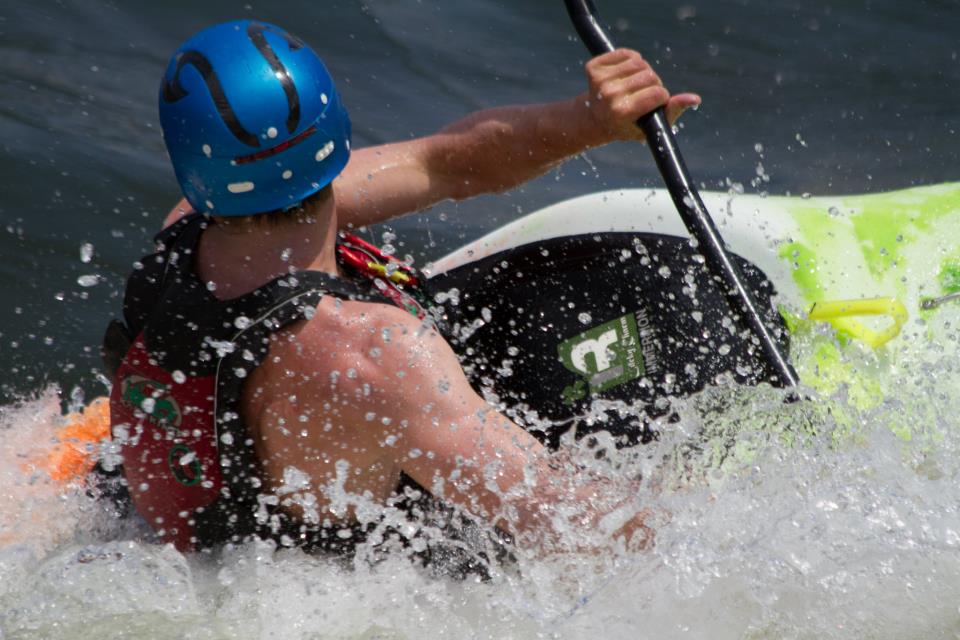
The Glenwood whitewater park was the first of its kind along the entire Colorado River. Lurline Underbrink Curran, the County Manager for Grand County, is hoping that the County can build the river'ssecond park at the mouth of Gore Canyon. Under the direction of the Grand County Board of County Commissioners, she has been working to keep water in the Upper Colorado for nearly thirty years and believes that finding a common ground on water issues "is the only thing that's going to keep this river whole in the future." Grand County recognizes the strong connection between the environmental health and economic strength on the Western Slope. But even without any immediate economic benefit, Underbrink Curran believes finding ways to ensure water stays in the river now is going to help us "save ourselves from ourselves in the future."
Whether the flows are secured for a whitewater park or for an endangered species, the whole system will see the benefit, now and in years to come. In a recent negotiation concerning the Denver and Northern Water's plans to divert up to 80 percent of the water above the confluence of the Fraser and Colorado Rivers, Underbrink Curran reported that "Grand County only bargained for water for the environment."
By keeping water in the Colorado River, by preserving the environmental benefits a flowing river brings, people and money are drawn to our state, and an investment has been made for our future. "A finite resource can have more than one function," she concluded. "Why not?"
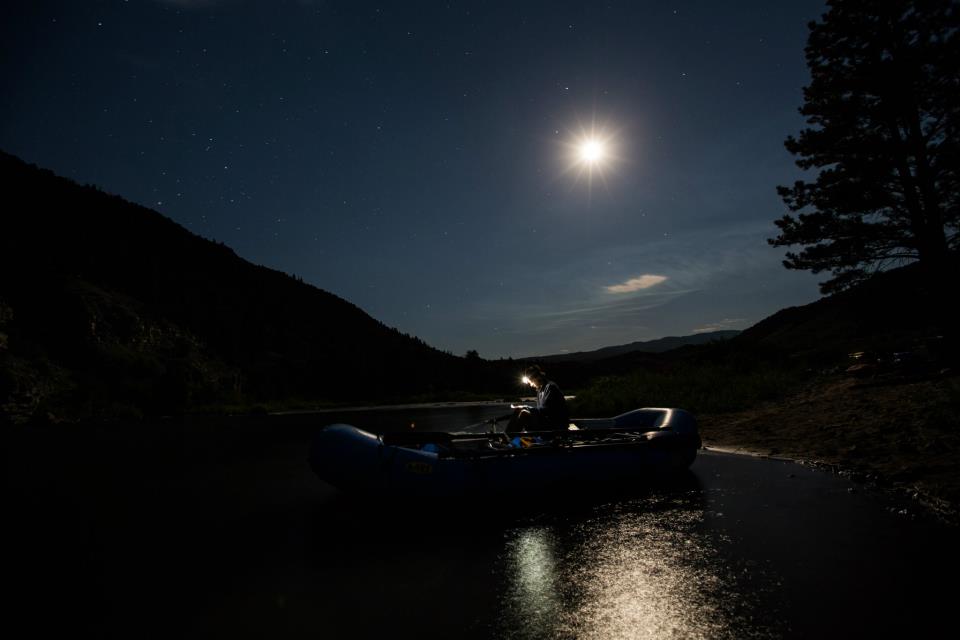
Reflections on Gore Canyon: River Recreation, Part I
This blog was originally published in the Huffington Post. Click here to read on Huffpo.
In the morning, we slide our kayaks into the Colorado River and paddle towards the rapids of Gore Canyon. The surface of river, slowly meandering its way through flat ranch lands near the town of Kremmling, is alive in the early light. A few strands of spiderweb fly by on an otherwise undetectable breeze. The bows of our boats cut through the water quietly.
After nearly two weeks spent following the Colorado River hiking on mountain trails, padding across reservoirs, and floating down the shallow, mostly flat upper river, we're looking forward to some whitewater. Last night we reached the confluence with the Blue River and the Colorado's flow was more than doubled. And now we're headed towards the first Class IV-V rapids of the trip, the 8-mile stretch that several locals referred to as "Big Gore Canyon." Gore is one of the few whitewater sections in the state of Colorado that has enough water to float a boat during this severe drought year, and we meet kayakers coming all the way from Denver and Durango. Of our four expedition members, three of us are paddling kayaks and have been down Gore many times before. Carson McMurray, the forth crewmember, is new to river running. He's piloting a small inflatable packraft and plans to hike around the bigger rapids.
All of us are a little anxious, but the Colorado, even with its increased volume, is in no rush to reach the notch in the mountains that marks the beginning of the canyon. It moves back and forth in lazy loops, flowing over sandbars, past flocks of pelicans and between more fragments of web. One strand in particular catches my eye. It's moving directly towards my boat as lazily as the river is moving towards the Gore Range. As it floats closer, I see there is something attached to the end -- an airborne spider dangling from its homemade sail of silk. It's losing altitude quickly and headed for the water a few feet ahead my kayak. I instinctively take a few strokes towards it, thinking I'll catch it on my bow and save it from a watery grave. But I miscalculate and it sails right over me, landing on the surface of the river. Amazingly, the web does not sink onto the water but remains in the air still being slowly propelled by the wind. The spider, seemingly unperturbed, skates across the surface of the water with its paraglider-turned-kite doing the work.
I watch the spider cruise away until I can no longer make it out against the grassy riverbank. Then I paddle on. I didn't come here expecting to watch spiders, and as the current finally begins to quicken my thoughts move elsewhere. The low grass banks turn to rugged rock walls towering 1,000 feet above us and soon the rapids begin.
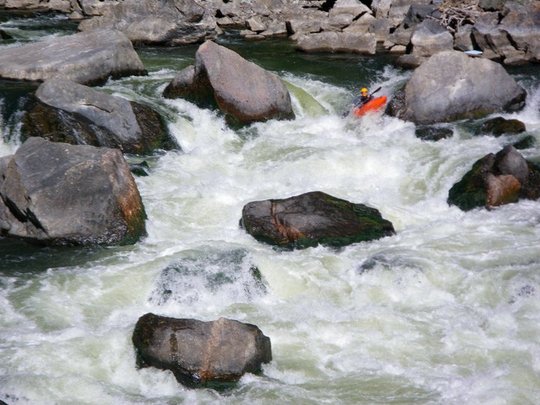
A few hours later we emerge from the other end of the canyon, our hair still dripping from under our helmets and the adrenaline subsiding. Since we launched this morning, the three of us in kayaks have found mostly what was expected: rapids forcing us to maneuver quickly between offset boulders, a few waterfall-like drops where our boats catch several feet of freefall before landing in the churning pockets of foam below, plus a few missed paddle strokes, several moments of terror, and a whole lot of hootin' and hollerin'.
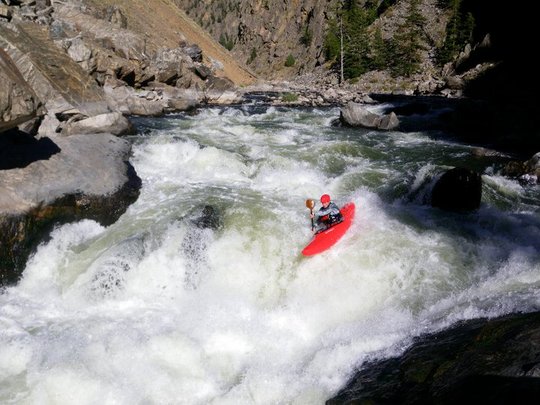
For the packrafter, Carson, it may have been a little less fun but more action packed. After piloting several Class III rapids (no small feat for a river novice in craft designed for crossing flatwater in the backcountry), Carson made more than one mad sprint through the train tunnels along the riverbank. He found it the easier than portaging the larger rapids over steep rocky slopes, though he had to pray the roar of the river wouldn't be enough to muffle the roar of an oncoming freight train. We all emerge unscathed. Even after all the excitement, even after weeks of hyping up Gore, the moment that stands out most clearly from the day is the sailing spider, bolder in my memory than any of the Gore's other rewards.
I think this is a fairly common experience for people who participate in any sport labeled as "outdoor recreation." Whatever it is that draws people to our public lands -- be it a scenic mountain trail, a prime fishing hole, a slope of fresh snow, or a series of rapids -- isn't always what stays with us when we return to civilization. Sometimes it's the unexpected encounters with a living landscape that bring us back out the next time and not the trophy catch or finding the best powder turns. Sometimes the sport may serve more as a way to discover that sudden revelation of color, a coyote's gaze, some remarkable geometry of tree branches, or a floating arachnid than anything else. But for the addicted outdoors enthusiast, their sport of choice just happens to be the most interesting way to arrive at that exceptional moment that cannot be planned or pursued. Playing out of doors and away from asphalt differs from recreating in an amusement park or a basketball court in that it takes us away from our homes and business. It takes us beyond the right-angled world we attempt to make useful and allows us to visit, however briefly, the more-than-human world living and dying beyond our control.


